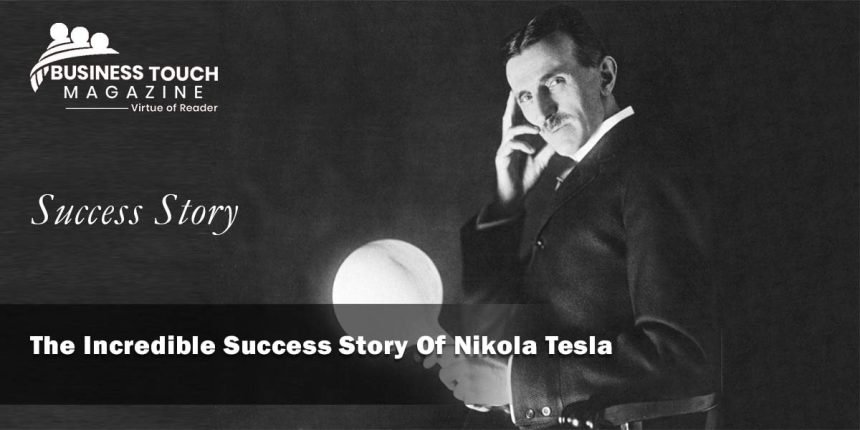Engineer and inventor Nikola Tesla is credited with developing the alternating-current (A.C.) electric system, which is now the most widely utilised kind of electricity in the world.
As a result of his work, the “Tesla coil,” which is still in use today in radio technology, was born.
His innovations were well-known and admired yet his business ventures were doomed to failure. His journey to achievement has been punctuated by highs and lows.
Early life
Nikola Tesla was born in Smiljan, Croatia, in 1856 and died in Stockholm, Sweden in 1947.
As an Orthodox priest, his father was also in charge of the family farm. Tesla’s brother died in a riding accident in 1863.
Tesla, who was just seven years old at the time, was shaken by the tragedy. His lifelong mental disorders began when he claimed to see visions.
The Technical University of Graz was where Tesla studied math and physics, while the University of Prague educated him in philosophy.
He came up with the concept for a brushless A.C. motor while out for a stroll in 1882. In the sand of the walkway, he sketched the whirling electromagnets.
Later that year, he relocated to Paris and worked for the Continental Edison Company, fixing direct current (D.C.) power facilities. Then, two years later, he moved to the U.S.
Tesla’s life in the United States
A couple of his own poems and calculations for a flying machine were all that Tesla had with him when he landed in New York City in 1884.
As an engineer at Thomas Edison’s Manhattan headquarters, he began his career During his year-long stint with the company, Edison was impressed by his knowledge and perseverance.
For Edison’s D.C. dynamos, he offered Tesla $50,000 in exchange for a better design. In the end, Tesla came up with a solution and sought for money to implement it.
Insulting Tesla for his lack of American humour, Edison said: “Tesla, you don’t get our sense of humour.” Soon after, Tesla resigned from his position.
Tesla & his Inventions
For his study on alternating currents after failing to launch his own Tesla Electric Light Company, Tesla found financial help.
After receiving more than 30 patents in the years 1887-1888, he was asked to speak before the American Institute of Electrical Engineers on his achievements.
George Westinghouse, the developer of the first A.C. power system, was drawn to his speech. In the “Battle of the Currents,” he was Edison’s main rival.
Tesla was employed by Westinghouse, who leased his A.C. motor patents to him and provided him with a lab of his own.
To demonstrate the dangers of the Westinghouse standard, Edison arranged for the execution of a convicted New York murderer in an AC-powered electric chair in 1890. Because of this, Tesla decided to go it alone once again.
Tesla, in the late 1890s, developed electric oscillators, metres, better lighting, and the Tesla coil, a high-voltage transformer.
Experimenting with X-rays, radio transmission, and a radio-controlled boat in Madison Square Garden’s pool were just some of the other things he did.
A partnership between Tesla and Westinghouse and General Electric resulted in the first modern power plant at Niagara Falls at the 1891 World’s Columbian Exposition in Chicago.
Struggles faced by Nikola Tesla
When Tesla’s laboratory in New York burnt down in 1895, he lost all of his notes and equipment.
He stayed in Colorado for the following two years before returning to New York in 1900 to finish his career.
After securing funding from a businessman, he set about creating a global network of communication. Unfortunately, he was forced to stop working due to a lack of funding.
When Tesla’s mental and physical health began to deteriorate, he continued to work on new inventions in his New York hotel room.
He spent the latter years of his life feeding and conversing with the pigeons that populate the city.
January 7, 1943, was the day of Tesla’s death in his own room. Tesla’s radio discoveries were finally recognised by the U.S. Supreme Court, invalidating four of Marconi’s essential patents later that year. The A.C. system he developed and perfected in terms of power transmission is still the gold standard.
Lessons We Can Learn
Nikola Tesla was a brilliant scientist and inventor, with over 300 patents to his name.
Despite the fact that he was denied credit for many of his findings, his work has endured to this day. Since his death, he has continued to be one of the greatest innovators ever to have lived.
Tesla was a fearless innovator who never hesitated to suggest ideas that were ahead of his time.
He wasn’t motivated by material gain, but rather by a desire to improve the world in which we now live.
Others were blind to Tesla’s vision. That means if others have previously deemed your ideas absurd, don’t waste your time attempting to persuade them that you’re correct.
Then start to work and don’t be scared to venture into the abyss. Don’t be afraid to test out your theories, even if no one else does.
Think beyond the box. Let the future reveal the truth and analyse what you can do to alter the world.




